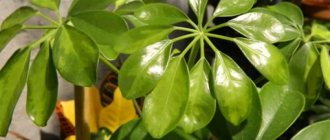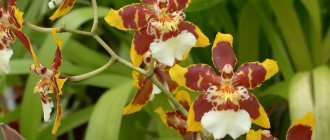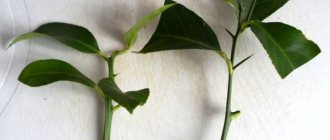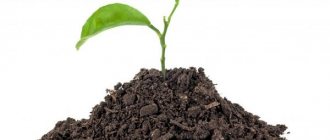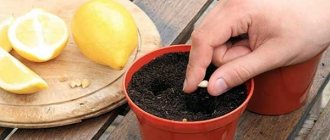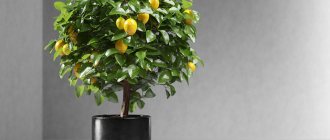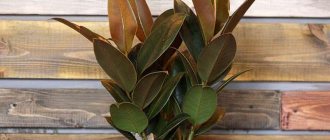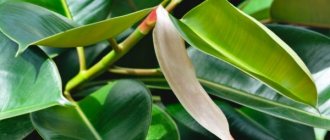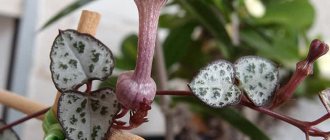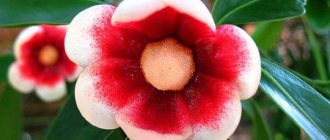Methods for propagating the Meyer variety
The Meyer variety can be propagated in 2 ways:
- By cuttings. Cuttings can be rooted in water or soil, as well as grafted onto seedlings to produce strong plants and accelerate their fruiting;
- Grow a Meyer lemon from a seed. When planting seeds, plants may not retain the varietal characteristics of the crop, but, nevertheless, this method of propagation is very popular and often gives excellent results.
Seeds must be sown in prepared soil, in small containers.It’s best to put one in each pot, so that later when replanting you don’t injure the roots of the seedlings. After planting the seeds (2–3 cm deep), the soil must be watered and the pots covered with film or placed in a plastic bag to prevent the soil from drying out. When 2–3 young leaves appear on the seedlings, they must be transplanted into pots and installed in a permanent place.
Rules for planting seedlings
Experienced citrus growers advise planting seeds and cuttings in soil mixtures purchased in specialized stores designed specifically for citrus fruits. The same mixtures should be used for planting store-bought plants, as well as for further replanting of trees.
When planting a young plant or a cutting rooted in water, as well as when replanting a tree, it is necessary to monitor the position of the root collar. You can't bury it
It is important to plant the seedling so that the root collar is flush with the soil surface
Each tree needs a separate pot, otherwise it will not be possible to grow a strong and fruit-bearing tree.
A small seedling cannot be planted in a large container. The pot must be the right size, and every year the tree must be replanted into a larger pot (plus 4–5 cm in diameter). Planting a small plant in a large pot will have a negative impact on growth and may cause the roots to rot.
Rooting cuttings
Propagation by cuttings has one advantage: trees obtained in this way begin to bear fruit much faster than those grown from seeds. You need to take cuttings from an already fruit-bearing tree.
As rooting material, you can use twigs left after the next spring pruning.
To root a Meyer lemon cutting, it should have 4 to 5 leaves. Stages of rooting cuttings:
- The finished material is placed for 20 hours in a solution of special rooting preparations or a weak solution of potassium permanganate. After this, the existing sections must be treated with charcoal, removing the 2 lower leaves (there should be 2 leaves left, or better yet 3);
- Immediately after this, the cuttings are placed in prepared pots;
- It is necessary to place drainage at the bottom of the pots, pour soil for citrus fruits on top, and sprinkle its surface approximately 0.5 - 1 cm with coarse and clean river sand;
- The cuttings should be inserted into the ground 3 cm deep;
- Caps must be placed on top of the pots. To do this, you can use clean glass jars or plastic bags. For rooting, cuttings require greenhouse conditions and a temperature of at least 20° C;
- Planted cuttings should be placed in a place with bright but diffuse lighting. If buds appear on the cuttings during rooting, they must be removed. The success of the process will be indicated by the appearance of a new leaf. After this, young trees need to be accustomed to new conditions by removing the cap for several hours a day, gradually increasing this time.
Why do Meyer lemon leaves turn yellow and fall off?
Most often, this phenomenon is caused by improper care. In most cases, this indicates insufficient watering and moisture, too dry air, and a lack of nutrients.
The reason for this may be too low a temperature, as well as watering plants with cold water and insufficient lighting.
In addition, excessive watering can lead to yellowing and falling leaves, as a result of which the root system begins to rot. In this case, it is necessary to normalize the conditions of the lemon:
- Regulate watering and spraying;
- Make a feeding schedule;
- Selecting the optimal fertilizer;
- Provide lemons with sufficient and complete lighting;
- Adjust the temperature.
If this phenomenon is caused by pests, it is necessary to treat the trees with special preparations.
Description and characteristics
The citrus tree is described as having attractive characteristics. Flower growers classify Meyer lemon as the best variety of the Citrus genus.
Maximum size and annual growth
Due to its miniature size of 1.5-2 m, Chinese wood fits harmoniously into a living space. Branches with dense foliage form on the main stem. The elongated leaves are dark green in color and have a smooth surface with a natural shine.
Flowering and pollination
The plant self-pollinates all year round. During the flowering period, snow-white flowers with a purple base are formed on the lemon crown. The citrus aroma scatters throughout the space, leaving no gardener indifferent.
Fruiting dates and harvest
Fruiting of the Meyer lemon variety occurs in the 4th year after planting the seeds. During the growing season, a lot depends on the care: if it was correct and regular, then the tree produces bright yellow fruits weighing from 70-150 g. Their peculiarity is their thin peel, which acts as a protection for the lemon pulp, but at the same time it is easy to peel.
Taste and beneficial properties of the fruit
Meyer fruits are superior in taste to other indoor varieties of lemons. With sufficient light and timely watering, the composition is replenished with sucrose, thereby diluting the acidity characteristic of the exotic fruit.
High levels of ascorbic and citric acid, vitamin A, B vitamins, pectins, potassium and copper salts make it a valuable product in traditional and folk medicine.
Tea with lemon protects the body from viral and colds, improves immunity, and replenishes vitamin deficiencies. Lemon zest and pulp are also used for cosmetic purposes.
Advantages and disadvantages
- Meyer lemon is not afraid of cold temperatures and can grow in almost any climate;
- The tree itself has an excellent decorative appearance and can become a decoration in any room;
- The fruits are very beautiful and at the same time tasty, which cannot but please gardeners;
- Flowering and fruiting last continuously, so with proper care you can harvest several harvests per season.
- In addition to all the advantages, the Chinese lemon has disadvantages, such as the need for constant and high-quality care, in the absence of which the tree can quickly get sick and die;
- There is also a high risk of various insect pests;
- The fruits are not suitable for long-term storage and transportation over long distances.
Read more: Kokinsky pear variety description photo reviews
Further care
Even if the Meyer lemon is indoors, agricultural care is still required. Watering, pruning, replanting and placing the bush will protect the tree from unwanted consequences.
Watering
In order for the humidity mark to be at the desired level, in warm seasons the young tree is watered 2 times a day, in cool seasons it is reduced to 2 times a week. In addition to root watering, the crown and main shoot are sprayed with water using a spray bottle.
Fertilizer
During the growing period of lemon bushes, mineral fertilizers are especially necessary. They buy special mixtures with nitrogen, potassium, and phosphorus. Starting from spring and until autumn, fertilize the soil once every 15 days.
Lemon transplanting and pruning
According to the recommendation of lovers of the Meyer lemon crop, the plant should be replanted every year in a container 4-5 cm larger. When the tree reaches the age of 5 years, the replanting time is reduced to 3 years.
The formation of the crown ensures uniform nutrition for all parts of the lemon tree:
- the main stem is reduced by 20 cm, fertile buds are left at the top;
- secondary shoots appear from these buds, which serve as the skeletal part, their number should not exceed 3-4 branches, the rest are removed;
- the remaining ones are shortened by 25 cm, the shoots of the second row are reduced by 10 cm, the third by 5 cm;
- on the fourth row the plant completes its vegetative development.
Wintering
In winter, the shrub requires moderation in care, the temperature should be in the range of 12-14 degrees, the lemon should be moved to a place away from radiators and heaters.
Prevention and treatment of diseases
Growing indoors reduces the risk of disease, but other negative factors may include lack of light and moisture. In the first version, the leaves become light green, in the other, they wither and fall off.
Pest protection
Common pests of lemon are spider mites and scale insects in the form of black dots. Spider mites are gotten rid of using a water jet. For scale insects, prepare a mixture of 50 ml kerosene with 100 ml liquid soap.
Diseases and pests
Meyer lemons are susceptible to disease due to improper care. A sign of the disease is a change in leaf color. It is dangerous when the foliage falls off or dies completely, but remains on the bush. Lightened foliage indicates that indoor citrus does not receive all the necessary moisture and nutrients.
The lack of light also affects the appearance of the foliage. Withering and falling leaves indicate a lack of moisture. Abundant watering or spraying the crown will help correct this situation.
Not only diseases (infections or fungi), but also pests threaten the bush. Spider mites build webs between branches and eat foliage or inflorescences. Scale insects also attack indoor varieties. They eat foliage and leave behind dark spots.
Pest Control
If the indoor variety has suffered from spider mites, the crown of the tree is washed with a stream of clean water. The procedure is carried out carefully so as not to break the young branches. After this, the Meyer variety is dried and sprayed with fertilizers.
The fight against scale insects is carried out immediately after the first black spots appear on the foliage. To do this, mix 50 ml of kerosene and 100 ml of soap solution. The entire green part of the plant is treated with the mixture.
Disease Prevention
As a preventative measure, spray the tree with a special solution twice a year. Dilute with 2 g of karbofos and 2 g of keltan. The active substances are diluted with water and applied to the surface of foliage and branches using a spray bottle. Preventive measures are carried out before the flowering period of the tree and after harvesting. If cobwebs or damage appear on the tree, the foliage is washed well to prevent the spread of pests.
How to Grow a Meyer Lemon from a Seed
Meyer lemons are relatively easy to grow from the seed. The sequence of actions will look like this:
- First, you need to extract the seeds from the fruit, wash them and dry them in direct sunlight.
- The dried seeds are wrapped in gauze, which is placed in a shaded place at room temperature. Every day you need to check the moisture level of the gauze and maintain it.
- As the seeds sprout, they are transplanted into the ground. It is recommended to use a mixture used for growing tomato or cucumber seedlings.
- Hatched seeds are placed at a depth of no more than 4 cm.
- The plants are watered daily. After about 2-3 days, sprouts appear on the surface.
- As soon as the lemon reaches a height of 15 cm, it is transplanted into a larger container.
- When the stem reaches a thickness of 8 mm, it is necessary to graft the Meyer lemon onto some citrus crop.
Important! Without grafting, when grown indoors, flowering and fruiting of Meyer lemon can occur from 3 to 5 years of life. A lemon grafted onto another plant begins to bloom the next year, and bears fruit after 2-3 years. The best varieties for grafting Meyer lemon are Pavlovsky, Kursky, Novogruzinsky and varieties close to them
The best varieties for grafting Meyer lemon are Pavlovsky, Kursky, Novogruzinsky and varieties close to them.
As soil for planting seeds, you can use a mixture of the following composition:
- leaf soil, sand and humus - 1 part each;
- turf soil - 2 parts.
The plant is transplanted into “adult” soil having the following composition:
- leaf soil, sand, humus and clay - 1 part each;
- turf soil - 3 parts.
Features of the variety
The advantage of the variety is that it can be grown in different regions of Russia and neighboring countries. The tree is not afraid of temperature changes. It decorates the interior and emits a refined aroma. The variety bears fruit well, however, you need to properly care for it. If you forget to add water, flowering will be disrupted, the leaves will turn yellow and begin to fall off. There may not be any fruit.
In some cases, indoor crops are overtaken by diseases. To avoid these, you need to loosen the soil, add water and fertilizer . The fruits are not stored for too long, it is important to take this feature into account. Useful compounds are added during the flowering and fruiting period. Lemon requires fertilizing when the growing season begins.
Complex formulations are applied once a week from March to September. They should contain the following microelements:
- nitrogen;
- potassium;
- phosphorus.
In order for the crop to absorb more valuable substances, it is necessary to fertilize the soil with a solution of manganese or iron once every three months.
Description of the Meyer lemon variety
The second known name for Meyer lemon is Chinese lemon. As a home citrus plant, this variety is very common and loved by many citrus growers. The tree has a beautiful appearance and is compact when pruned in a timely manner.
The variety produces a very large number of fruits, a characteristic feature of which is the high content of vitamin juice.
The plant is easy to grow at home, as this lemon is relatively unpretentious. Thanks to this, in many countries, Meyer lemon is an industrial crop and is grown over very large areas.
Flowering and fruiting
This variety of lemon begins to bloom very early, as a rule, already from the 2nd year of life, if the tree is grown from a rooted or grafted cutting taken from an already fruit-bearing tree.
Photo of Meyer lemon blooming
Lemon flowers are quite large, snow-white, and have a very pleasant, fresh and quite pronounced aroma that fills the entire room.
At home, Meyer lemon usually grows into a small tree, but it can also take the form of a bush, which largely depends on the formation of the growing seedling and its pruning.
The flowers are evenly spaced, and sometimes the buds may have a slight lilac tint at the base. In young seedlings, the flowering process must be controlled.
Since the tree can bloom already from the second year, this cannot be ignored. If at the time of releasing the first buds the tree does not have many leaves or looks weak, then it is recommended to remove the buds.
The variety is characterized by continuous fruiting; flowers and fruits are formed throughout the year.
In one season, it is often possible to get about 3 kg of juicy lemons from one small tree. The peak of flowering is observed in the spring, since at this time the buds appear in whole clusters of 5 - 7 pieces each. The number of ovaries formed depends on the correct care of the tree. Full ripening of the fruit occurs in 8–9 months.
Crown and its characteristics
In normal home conditions, Meyer lemon usually grows up to one and a half meters in height, but in most cases the tree is slightly lower, but has a very wide crown. The peculiarity of this type of lemon is that it grows side shoots quite quickly and in large numbers, most of which quickly begin to bear fruit.
The spines of this lemon variety are small and there are practically no spines on the branches; most of them are concentrated on the surface of the main trunk. Generally, Meyer lemons don't tend to grow into nice tree shapes.
Photo of the crown of a Meyer lemon variety
Most often, it forms the form of a low and very spreading bush, which is much more convenient for abundant fruiting. To form a tree, it is necessary to carry out special regular pruning from the first year of life.
The leaves of this tree are small, numerous, dense, quite hard, have a dark green color and have an attractive glossy shine.
Their shape is mostly ovoid, but small serrations can be observed along the edges of the leaf blades. If the leaf of this lemon is rubbed in the palms, an aroma will appear that is reminiscent of citrus essential oil, which is uncharacteristic of the lemon tree, which indicates that the variety is a hybrid.
Lemon fruit
Normal and stable fruiting of Meyer lemon seedlings usually begins in the 3rd year. Meyer lemon fruits are small and round in shape. Their weight can reach 100 – 150 grams. The main feature of the fruits is that when ripe they bear little resemblance to lemons.
When fully ripe, their zest acquires a dark yellow color with a very pronounced orange tint.
The peel of the fruit is thin, aromatic, smooth, and has a slightly sweet taste. The pulp of the fruit also has a dark yellow color, is distinguished by its juiciness and special taste, uncharacteristic of other varieties.
Their taste is quite sweet, with a hint of orange, and does not have as much acid as the fruits of other lemon varieties.
There are very few seeds in these lemons, usually only a few pieces. These lemons are practically never found in stores, since although the fruits are stored quite well at home in the refrigerator, they tolerate transportation, especially over long distances, very poorly.
How to pick lemon fruits correctly
The height of the plant in open ground can reach 5 meters. However, in indoor conditions it rarely reaches a height of more than 2 meters. On average its height is 1 meter.
The leaves are small, evergreen, and have a dark green tint. It blooms very beautifully: the inflorescence has the shape of a cluster. The flowers are small in purple or white. The flowers smell very nice.
The fruits are round in shape and small in size. On average, the weight of the fetus is 100 grams. The peel is orange or bright yellow.
It has a specific taste. More reminiscent of an orange than a lemon. And you shouldn’t be surprised at this: after all, Chinese lemon is a natural hybrid of lemon and orange.
When assembling, it is important to use scissors or a knife, which will make the process neater. The number of fruits will depend on many factors. This includes the age of the plant, the correctness of feeding and irrigation, and the creation of the necessary climate. The same factors will determine taste. Growing Meyer lemons at home is a pleasant experience because of the wonderful fruits, but it also requires a lot of attention and work.
What kind of plant is this? Meyer lemon (Latin name Cítrus × méyerii) is a perennial plant of the Rutaceae family, a hybrid of an orange and a lemon. It was first brought to the United States from China by scientific researcher Frank Meyer in 1908. The second name of the plant is Chinese dwarf lemon.
In its homeland it grows under natural conditions and reaches a height of 6–8 meters. Gradually, from the USA, the variety spread throughout the world, and it began to be grown as a houseplant. And its fruits began to be used in cooking.
In room conditions it grows 1–2 meters. The crown is round, compact, and lends itself well to shaping. The leaves are small, shiny, oval, dark green in color, with jagged edges. Inflorescence in the form of a cluster.
Reference. The flowers are snow-white or purple, strongly fragrant, formed on both adult shoots and young branches.
The fruits are small, round, without a nipple, from 70 to 140 grams. The lemon zest is dark yellow in color and turns orange after a while. The peel is smooth and thin. There are 10–12 seeds per fruit.
What you need
Meyer lemon is distinguished at home by its small size and moderate growth rate. At the same time, the bush is characterized by excellent productivity and resistance to low temperatures. A tree at home can bloom several times all year round, with the greatest flowering occurring in spring.
When choosing Meyer lemon for home growing, you should remember that the harvested crop does not have good shelf life and does not withstand processing well. Therefore, if you plan to grow lemons for sale at home, then the Meyer variety, despite its ease of care, is not suitable for these purposes.
Fruiting of this variety of citrus fruits usually begins at home at 5-7 years of the tree’s life. Over the course of a season, from a large lemon tree of this variety you can get 2-3 kilograms of fruit that tastes great. It should be borne in mind that from the formation of the ovary to the ripening of the fruit, even with intensive care, about 9 months pass.
Planting, caring for and growing indoor lemons of this variety is not particularly difficult. You can use either cuttings from fruit-bearing indoor lemons or plant seeds from fruits obtained from a varietal tree. Experts recommend using small cuttings for planting at home, which not only speeds up the first harvest, but also solves problems with late flowering, which can be observed in trees grown from seed.
Propagation by cuttings at home is carried out using standard technology. You need to cut a small 10-centimeter branch with several fully developed leaves and three to four buds. It is recommended to soak the lower part of such a cutting for several hours in a growth stimulator, and then plant it in fertile soil to a depth of about 3 centimeters.
Humidity
What is Meyer lemon
Over time, it was possible to develop an improved, disease-resistant variety of Meyer lemon. There are countries where it is bred on an industrial scale. But it has gained the greatest popularity as an ornamental fruit-bearing plant among gardeners who grow Meyer lemon at home.
It is loved for its compact size and high yield. This is a dwarf species from the citrus genus, reaching a height of no more than 1.5 meters. Lifespan – up to 50 years.
Features of the plant:
- The leaves are dark green and have small serrated edges.
- The flowers are small, white, with a subtle purple hue. They have a subtle aroma. You can even brew tea from lemon flowers, which has a very subtle jasmine aroma. It blooms very intensely, so some of the flowers must be plucked so that they do not draw a lot of nutrients from the plant and inhibit its growth.
- Meyer lemon fruits are different from the lemons sold in stores. They are round, rich yellow or orange. The peel is smoother and thinner, without the usual tubercles, like other varieties. The pulp is orange in color and very juicy. The taste is sweet and sour with a hint of bitterness. There are always a lot of seeds inside.
It has a high content of vitamin C, which makes it a popular antipyretic. Indispensable for boosting immunity during colds. The fruits appear after 8 months of flowering. The tree can be harvested almost all year round. An adult tree produces up to 3 kg of lemons per season.
Description of appearance, flowering and fruits and photo of the plant
In room conditions it grows 1–2 meters. The crown is round, compact, and lends itself well to shaping. The leaves are small, shiny, oval, dark green in color, with jagged edges. Inflorescence in the form of a cluster.
Reference. The flowers are snow-white or purple, strongly fragrant, formed on both adult shoots and young branches.
The fruits are small, round, without a nipple, from 70 to 140 grams. The lemon zest is dark yellow in color and turns orange after a while. The peel is smooth and thin. There are 10–12 seeds per fruit.
Below are photos of Meyer lemon:
Description of culture
Indoor lemon is an evergreen dwarf tree with thorns on its branches. Lemon leaves are bright green, oblong, very dense. They contain glands with essential oils that bring a pleasant, fresh citrus smell into the room. Young pagons stand out with a rich violet-purple hue. The buds take about five weeks to develop. The flowers are white, collected in inflorescences, and are characterized by a pronounced aroma. One flower can live up to nine weeks.
Lemon in buds
The process of fruit ripening can last more than nine months. They are mainly egg-shaped with a tubercle at the base. Color and size may vary from deep green to pale, almost yellow or striped. There are lemons whose weight exceeds 100 g, and there are smaller ones - up to 50 g.
Important! If a ripe fruit is not picked, it can hang for a long time without losing its attractive appearance, but the taste will deteriorate - the pulp will become dry and hard
Pros and cons of the variety
Meyer's advantages include the following:
- high adaptability to new growing conditions;
- ability to withstand low temperatures;
- good taste of fruits;
- long and frequent fruiting.
One of the disadvantages of lemon is that it is demanding in terms of care. Failure to comply with growing rules leads to the rapid death of the tree. Meyer fruits are not suitable for long-term storage.
Meyer lemon: care for the variety at home
According to expert research, Meyer lemon is a hybrid variety (the result of crossing a lemon and an orange). Why is this tree often called Chinese lemon?
In 1908, scientific researcher Frank Meyer first introduced lemon fruits to the United States, which had much in common with oranges.
Since this variety was discovered in China, the second name is predetermined by its origin - Chinese dwarf lemon.
What do standard or bush Meyer lemons look like? This is a low-growing citrus tree, the height of the trunk of which, when grown at home, does not exceed 1 meter.
Feature of a tropical plant: it blooms several times a year. The flower petals are white or light purple in color and exude a subtle, captivating aroma. Inflorescences are collected in clusters. The foliage is rich green throughout the year.
https://youtube.com/watch?v=o4nxsZRag2I
What fruits are typical for indoor Chinese lemons? Small citrus fruits with almost no seeds. The shape is round. The peel is yellow in color with pronounced notes of orange. The fruits are juicy and aromatic, the flesh is soft orange in color.
Pros and cons of growing
Like any tropical plant grown indoors, lemon of this variety has both its advantages and disadvantages of cultivation.
The positive points include:
- interesting appearance of a home citrus tree;
- tolerates cold and can be grown in different climatic zones;
- subject to appropriate maintenance conditions, citrus of the dwarf variety blooms profusely (often many times throughout the year) and bears fruit well;
- performs not only a decorative function, but also produces delicious juicy fruits.
Negative characteristics include:
- a high tendency to various diseases and attacks by insect pests if the rules for the care and maintenance of a standard or bush plant are not followed;
- citrus, the fruits of which are unsuitable for transportation and long-term storage.
How to create the necessary conditions
Do you want to grow indoor lemon on your windowsill? Follow a number of simple conditions and rules from professionals, and soon your home garden will be replenished with a beautiful tropical plant
So, what recommendations should you follow? What should you pay attention to?
Lighting and location
Caring for Meyer lemons involves providing adequate light. The optimal daylight hours are 12 hours. During the winter season, you will need support with phytolamps that provide scattering light.
Chinese lemon is light-loving, but a large amount of sunlight can cause burns on the tree. The best place to place a lemon flower pot will be the western or southeastern side of the house.
Humidity
For a comfortable existence of citrus indoors, do not forget to maintain the required level of air humidity. A tropical plant loves moisture, so the optimal value would be a humidity level of at least 60–70%. At lower or higher rates, this variety of standard or bush lemons may become sick and die.
Meyer Lemon Care Guidelines
Meyer lemon does not require special care at home. The key points of keeping citrus fruits are the organization of watering, replenishment with useful substances and minerals, the formation of the crown (trunk or bush) and the prevention of diseases characteristic of citrus fruits grown in the house.
Feeding with fertilizers
Fertilizers are traditionally applied during the growing season (from early spring to late summer).
You can use both organic fertilizers and ready-made mineral complexes. It is recommended to purchase complex fertilizers labeled “for citrus fruits” in flower shops, which are rich in potassium, phosphorus and nitrogen. In winter, lemons do not need to be fertilized with minerals and other beneficial substances.
Disease prevention and insect control
Pests that have chosen citrus trees include scale insects, spider mites and aphids. Timely identification of signs of the presence of insects will help protect the lemon tree from death. Do not forget to periodically examine the citrus tree for symptoms of any ailments. After all, it is better to prevent any disease than to eliminate its consequences later.
Botanical description
What kind of plant is this? Meyer lemon (Latin name Cítrus × méyerii) is a perennial plant of the Rutaceae family, a hybrid of an orange and a lemon. It was first brought to the United States from China by scientific researcher Frank Meyer in 1908. The second name of the plant is Chinese dwarf lemon.
In its homeland it grows under natural conditions and reaches a height of 6–8 meters. Gradually, from the USA, the variety spread throughout the world, and it began to be grown as a houseplant. And its fruits began to be used in cooking.
Lemon propagation at home
Growing lemons at home is not difficult. Both generative and vegetative methods of propagation are used. Both options have advantages and disadvantages.
Seeds
Seed propagation of lemon in most cases only produces a wild plant. However, such a tree is characterized by increased endurance and unpretentiousness. Later it blooms and produces less tasty small fruits than cultivated plants, but it becomes a good rootstock for various varieties and hybrids.
To grow lemon from seed, it is important to choose suitable planting material. To obtain it, the fruit must be ripe and have a uniform color.
It should be free of rot, stains and other signs of infection by infections and pests.
Good bones are light, convex on both sides and elastic. They are distinguished by uniform color and absence of spots.
Seeds are sown to a depth of 1-1.5 cm in a common container. After planting, the soil is watered with water, covered with film and put in a warm place.
After the emergence of seedlings, the plants begin to ventilate, gradually increasing the duration of the procedure. They are planted in individual containers after the appearance of 2 true leaves. The next time the transplant is carried out when the roots fill the pot.
Cuttings
Cuttings allow you to obtain a varietal lemon with the characteristics of the mother plant. The tree begins to bear fruit already in 3-4 years. However, plants obtained from cuttings have less endurance than those grown generatively.
Cuttings for growing lemon are purchased from nurseries or cut independently from a fruit-bearing tree. The mother plant should not show signs of pest or infection. The branches from which planting material is obtained must also be healthy.
Leave such a distance from the edge of the branch so that there are 2-3 live buds on the pruning. The cuttings are soaked in a light pink solution of potassium permanganate and a root formation stimulator.
Then the cutting is dug into the ground so that it stands without support. The ground is watered, the branch is sprayed with warm water and covered with a bag. Ventilate and spray daily.
Rooting is indicated by awakened buds. If the seedlings are in a common container, they are picked at this stage. When planting directly into individual pots, transplantation is carried out when the root system fills the entire container.
Vaccination
Grafting is used to obtain poorly rooted varieties or to cultivate wild game grown from seed. It is more convenient to graft the rootstock onto the young scion. In this case, the plants are cut so that only the trunk remains.
A cut 1.5-2 cm deep is made in the center of the trunk. The branch from the cut side is ground so as to form a wedge. The scion wedge is inserted into the rootstock cut. The junction is wrapped with garden tape or electrical tape.
The grafted lemon is placed under a bag or cut bottle, ventilated and watered regularly. The formation of leaves and shoots indicates that the scion has taken root.
Rules for transplanting lemons
In the process of growing indoor plants, replanting is one of the main tasks, and if done correctly, a good result is guaranteed. Meyer lemon cannot be considered a capricious plant, but it is also impossible to treat it negligently. Lemon transplantation is done annually. The best way is transshipment. It will require good drainage. In order for young plants to take root, we pay attention to the soil.
The proportions here are:
- leaf soil - part
- sand - part
- humus - part
- turf land - two parts
The proportions of soil for an adult tree look slightly different:
- leaf soil - part
- sand - part
- humus - part
- fatty clay – part
- turf land - three parts
When replanting, the main thing is to create all the necessary conditions so that the plant - adult or young - can adapt faster to the new environment. It is important to remember the rule: as the plant ages, it increasingly needs fertilizer. It must be applied after irrigation. When using artificial lightening in winter, it is necessary to make the fertilizer more intense.
Lemon tree care
In order for a tree to grow strong and healthy, it needs to be properly cared for, while creating the most comfortable living conditions possible, close to the region of natural growth of such a plant. Quality care consists of several aspects.
Lighting
In order for the plant to fully bear fruit, it needs to be provided with intense sunlight throughout the year. The best option would be to create a 12-hour day, in such conditions the tree actively grows foliage, but if the number of daylight hours decreases, there is a risk that the lemon will lose all its green mass and simply die.
Flower growers recommend placing a pot with a plant on a western or eastern window sill, and in winter it is necessary to have artificial lighting.
Temperature
Mayer's lemon does not tolerate drafts and sudden temperature changes very well, so it is not recommended to place the plant on an unglazed and unheated balcony or outside.
Meyer lemon is adversely affected by drafts and temperature changes.
In summer, it is important to avoid overheating, so in intense sunlight and a lot of heat, it is best to slightly shade the tree so that it receives the right amount of light, but is not burned by high temperatures. The ideal temperature is 20 degrees Celsius
In winter, it is necessary to maintain a dormant state of the lemon tree; for this, the pot is moved as far as possible from the radiators, trying to provide the plant with a comfortable temperature of no higher than 12 degrees.
Watering
For a comfortable existence of the plant, it is recommended to maintain indoor humidity at 70 percent.
Lemon trees need to be watered using both root and foliar methods. Simultaneously moistening the soil and spraying the foliage with a spray bottle. In spring and summer, the procedure is repeated in the morning and evening every day; in autumn and winter, the frequency of watering is reduced to 2 times a week.
The earthen ball should always be moist; drying out can lead to the death of the plant.
Trimming
To form a beautiful tree crown, you need to take care of its pruning in advance, for this you need:
- The grown stem of the seedling is shortened to a length of 20 centimeters, leaving several developed buds in the upper part;
- The shoots that grow from the remaining buds will become skeletal branches, of which 3-4 are selected the healthiest, and the rest are cut off;
- Skeletal branches are cut to a length of 25 centimeters;
- Second-order shoots should be no more than 10 centimeters;
- Third order - more than 5 centimeters.
Meyer lemon pruning diagram
As soon as shoots of the 4th order appear, the formation of the tree crown is considered complete. Now every year in spring, sanitary pruning is carried out, removing all diseased, yellowed, dried or damaged leaves.
Landing rules
Young plants are recommended to be planted in a soil mixture obtained from sand, leaf soil, humus and turf (proportions, respectively, 1: 1: 1: 2). For mature trees, a similar substrate is prepared.
In this case, it is recommended to add one part clay and three parts turf to the mixture, leaving the other ingredients in the indicated proportions.
The root collar of the plant should be placed at ground level. In the first 5 years, the lemon must be replanted annually into a new larger container. In the future, this procedure must be repeated every 3 years. It is highly not recommended to immediately plant a tree in a large container. In this case, the root system may rot.
Home care
In principle, it is not difficult to care for it. But you should be aware of some features.
When purchasing a Chinese lemon (if you have not propagated it yourself), you should find out whether the plant is grafted or rooted. It was grown from cuttings or from seedlings.
It is important to remember that Meyer lemon is an evergreen subtropical plant, and care should be taken in advance to organize additional artificial lighting if there is not enough natural light.
Lighting
Requires a lot of light. Therefore, if the plant is located in an apartment, it should be installed near a south window. If the plant is located on the street, then it is installed in the most illuminated place.
If there is little natural light in the room, then you should take care of artificial lighting. It responds positively to direct sunlight and does not require additional shading.
Temperature
cold winter
If you don’t do this, then next year it simply won’t bear fruit.
Lemons are very sensitive to temperature changes! And if it is possible to take the plant out into the yard, then this should not be done immediately, but gradually. Meyer lemons should be acclimated to outdoor temperatures and direct sunlight. In the fall, they do exactly the same thing, only now the plant is brought back into the room.
Air humidity
This is a very important parameter. Since the plant originally grew in the tropics, it requires a humid climate.
Therefore, they are installed indoors at some distance from heating radiators, and the air around the plant is regularly sprayed with water. The more moisture in the air, the better for lemon.
Watering the plant
Watering must be done regularly! On hot summer days, the plant is watered every day. In winter, when dormancy sets in, it is enough to water a couple of times a week.
When watering, do not flood the earthen ball! It will be enough to moisturize it.
To avoid flooding, you should create a good drainage system in the pot before planting. Then excess moisture will not accumulate at the roots, and they will not rot.
Bloom
In order for the plant to bear fruit abundantly, it is necessary to achieve high-quality flowering. To do this, if the plant is young and weak, all flowers that appear are removed.
At this stage there is another task - the plant must get stronger. When an adult plant blooms, one ovary remains, and all other inflorescences are removed again.
Fertilizer
feeding through leaves
To do this, the plant is sprayed with water to which fertilizers intended for citrus fruits are added.
If the plant is recently transplanted, it does not require fertilizer. It is enough to water it regularly and abundantly.
After the tree has adapted and become stronger, you can feed it. For this purpose, mineral and organic fertilizers are used.
The feeding process is seasonal:
- April – September 2-3 times per month;
- January-April 4 times a month.
Summing up
When describing our hero, we often used the word “unusual”. Indeed, Meyer lemon stands apart from other varieties. Did you notice that its Latin name doesn't even contain the word "Lemon"? Many experts, biologists, as already mentioned in passing, propose not to consider it as such at all. But it’s also not possible to “push” an obstinate person to another type of citrus. He is different from everyone else in some way - an individualist!
In the USA, and not only there, it continues to be a popular industrial crop. Along with this, it has gained a reputation as an excellent plant for indoor cultivation. Flower lovers like its yield, early ripening, and small size. It is also important that its branches take root well by cuttings. True, you can’t call it easy to care for; it has its own vagaries.
In order for Meyer to grow successfully in the house, it is important to provide him with a cool winter with relatively humid air. This could be, for example, an unheated but insulated loggia. Ideally, the room temperature at this time of year should be between 5 and 12 °C.
In summer, an abundance of light and also slightly increased humidity are important. It will be great if the owner manages to take the pot with the tree into the garden, or at least onto an open balcony, protecting the specimen from harsh sunlight.
If you create such conditions for it, the Meyer lemon will definitely thank the owner with a bountiful harvest and a magnificent decorative appearance!
Reproduction
Lemon hybrids are propagated only vegetatively, this also applies to Meyer. Seeds collected from its fruits will produce a wild plant that does not inherit its parental characteristics.
Most often, the crop is propagated by cuttings. To do this, select a healthy one-year-old branch and prune it so that 2-3 healthy buds remain on the pruning. The cuttings are treated with a solution of potassium permanganate and Kornevin.
Planting material is rooted in water or soil. When shoots begin to appear from the buds, the seedling is dropped into a ceramic container with drainage holes.
Growing technology
Even novice gardeners can grow a lemon tree with orange fruits at home. The plant requires attention and regular care, but you won’t have to spend a lot of time on it.
Optimal conditions
To prevent citrus from getting sick and to develop properly, it is important to provide it with optimal conditions for growth:
- Temperature. During the growing season it is maintained within +18…+25°C. +20°C is considered optimal. In winter, the plant is moved to a room with a temperature of +5…+12°C.
- Humidity. This figure should not be lower than 70%. In summer, in the morning and evening, the leaves are sprayed with warm, settled water. In winter, use a humidifier or place containers of water near the lemon.
- Lighting. The culture requires 12 hours of daylight; it is better to place it on a southern windowsill. When the sun is most active, the window is shaded with a translucent curtain. If the lemon is dormant in winter, it is not necessary to use additional lighting.
If it is not possible to provide citrus with a lower temperature in winter, it is grown as usual. In this case, it will not be at rest. Then you will have to use lighting with phytolamps placed at a distance of 15–20 cm from the pot.
Important! Meyer lemon does not tolerate sudden changes in temperature. Before taking it outside, bringing it into the house or lowering the temperature for the winter, the tree must be hardened.
Rules for planting and transplanting
For planting and replanting a plant, it is important to choose suitable soil. Lemons are not recommended to be planted in peat soil. Therefore, it is better to buy either special soil for citrus fruits or prepare it yourself.
For young plants, the soil mixture should look like this:
- turf - 2 parts;
- humus - 1 part;
- sand - 1 part;
- leaf soil - 1 part.
All ingredients are mixed. Add 1 tbsp to a bucket of soil. ash and 1 matchbox of superphosphate.
For mature plants use heavier soil:
- turf - 3 parts;
- leaf soil - 1 part;
- sand - 1 part;
- humus - 1 part;
- clay - 1 part.
HOW TO PROPERLY TRANSPLANT A LEMON

